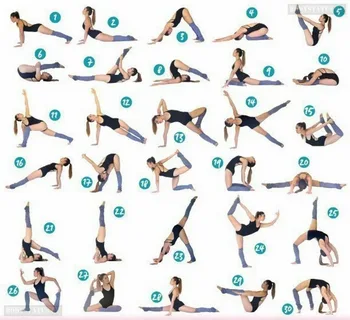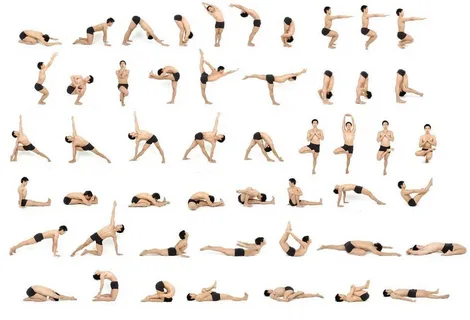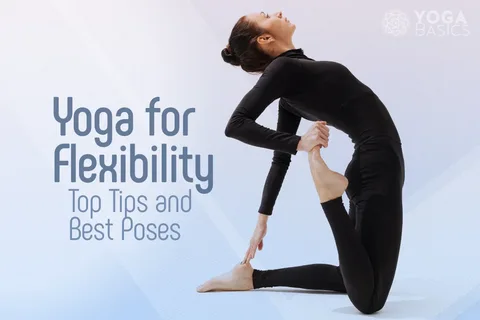In today’s fast-paced world, maintaining flexibility is crucial for overall health and well-being. Yoga, with its emphasis on stretching and mindful movement, is an excellent practice for enhancing flexibility and increasing mobility. Whether you are an experienced yogi or a beginner looking to improve your range of motion, incorporating specific yoga poses into your routine can significantly benefit your body. This article explores top yoga poses designed to enhance flexibility and mobility, offering practical tips and answering common questions to help you get started.

Why Flexibility Matters
Flexibility is more than just the ability to touch your toes; it plays a vital role in overall physical health. Increased flexibility can:
- Improve Range of Motion: Enhanced flexibility allows your joints to move through their full range of motion, which can improve overall physical performance and reduce the risk of injuries.
- Enhance Posture: Flexible muscles and joints contribute to better posture, reducing strain on the spine and helping prevent back pain.
- Boost Circulation: Stretching improves blood flow to muscles and tissues, which can aid in recovery and overall vitality.
- Reduce Stress and Tension: Yoga poses that focus on stretching and breathing help release tension and promote relaxation.
- Support Balance and Stability: Flexibility supports better balance and stability, which is essential for preventing falls and maintaining functional movement.
Top Yoga Poses to Increase Mobility
1. Downward-Facing Dog (Adho Mukha Svanasana)
Benefits: This pose stretches the hamstrings, calves, and spine, and strengthens the arms and legs.
How to Do It:
- Start on your hands and knees with wrists directly under shoulders and knees under hips.
- Spread your fingers wide and press into the floor.
- Lift your hips towards the ceiling, straightening your legs as much as possible.
- Keep your heels pressing towards the floor and your head between your arms.
- Hold for 30 seconds to 1 minute, then release.
2. Forward Fold (Uttanasana)
Benefits: This pose stretches the hamstrings, calves, and lower back, promoting flexibility and relaxation.
How to Do It:
- Stand with your feet hip-width apart and arms by your sides.
- Hinge at the hips and fold forward, reaching your hands towards the floor.
- Bend your knees slightly if needed to avoid straining your lower back.
- Let your head hang heavy and relax your neck.
- Hold for 30 seconds to 1 minute, then slowly rise to standing.
3. Lizard Pose (Utthan Pristhasana)
Benefits: This deep lunge stretches the hip flexors, groin, and hamstrings, and opens up the hips.
How to Do It:
- Start in a high plank position.
- Step your right foot forward and place it outside your right hand.
- Lower your hips towards the floor, keeping your left leg extended behind you.
- You can lower your forearms to the floor for a deeper stretch or keep your hands on the ground for support.
- Hold for 30 seconds to 1 minute, then switch sides.
4. Cobra Pose (Bhujangasana)
Benefits: This pose stretches the chest, shoulders, and abdomen, and strengthens the lower back.
How to Do It:
- Lie face down on your mat with your legs extended and tops of your feet pressing into the floor.
- Place your hands under your shoulders, elbows close to your body.
- Press into your hands and lift your chest off the floor, extending your back.
- Keep your shoulders away from your ears and gaze slightly upwards.
- Hold for 20 to 30 seconds, then release.
5. Pigeon Pose (Eka Pada Rajakapotasana)
Benefits: This pose opens the hips, stretches the glutes, and alleviates lower back tension.
How to Do It:
- Start in a tabletop position.
- Bring your right knee forward and place it behind your right wrist.
- Extend your left leg straight back, lowering your hips towards the floor.
- Fold forward over your right leg, reaching your arms in front of you or resting your forehead on the mat.
- Hold for 30 seconds to 1 minute, then switch sides.
6. Butterfly Pose (Baddha Konasana)
Benefits: This seated pose stretches the inner thighs, groin, and knees, promoting flexibility in the lower body.
How to Do It:
- Sit with your legs extended and then bend your knees, bringing the soles of your feet together.
- Gently press your knees towards the floor with your elbows while keeping your back straight.
- Hold your feet with your hands and gently press them towards your body.
- Hold for 30 seconds to 1 minute, then release.
7. Bridge Pose (Setu Bandhasana)
Benefits: This pose stretches the chest, neck, and spine while strengthening the back and core.
How to Do It:
- Lie on your back with your knees bent and feet hip-width apart.
- Press your feet into the floor and lift your hips towards the ceiling.
- Clasp your hands under your back and press your arms into the mat for support.
- Keep your thighs parallel and squeeze your glutes.
- Hold for 30 seconds to 1 minute, then slowly lower your hips back to the floor.
8. Cat-Cow Pose (Marjaryasana-Bitilasana)
Benefits: This dynamic stretch improves flexibility in the spine and helps relieve back tension.
How to Do It:
- Start on your hands and knees with wrists directly under shoulders and knees under hips.
- Inhale as you arch your back, lifting your head and tailbone towards the ceiling (Cow Pose).
- Exhale as you round your back, tucking your chin to your chest and drawing your navel towards your spine (Cat Pose).
- Repeat for 30 seconds to 1 minute, moving smoothly between the two positions.
Tips for Enhancing Flexibility
- Warm Up Properly: Always warm up before stretching to prevent injury. A few minutes of light cardio or dynamic stretches can prepare your muscles.
- Be Consistent: Regular practice is key to improving flexibility. Aim to incorporate stretching into your routine several times a week.
- Listen to Your Body: Pay attention to your body’s signals and avoid pushing yourself into painful positions. Stretching should be gentle and comfortable.
- Use Props: Yoga blocks, straps, or blankets can help support your practice and deepen stretches safely.
- Practice Mindfulness: Incorporate deep breathing and mindfulness into your stretching routine to enhance relaxation and effectiveness.

FAQs:
1. How often should I practice these poses to see improvements in flexibility?
Practicing these poses consistently, at least 2-3 times per week, can lead to noticeable improvements in flexibility. Regular practice helps gradually lengthen muscles and increase mobility.
2. Can beginners perform these poses, or are they only suitable for advanced practitioners?
Most of these poses can be modified for beginners. Start with gentle variations and use props for support. As you gain confidence and flexibility, you can gradually deepen the stretches.
3. How long should I hold each pose for the best results?
Holding each pose for 30 seconds to 1 minute is generally effective. Focus on breathing deeply and relaxing into the stretch to maximize benefits.
4. What should I do if I feel pain while doing these poses?
If you experience pain, stop the pose immediately and assess your form. Pain is a sign that you may be overstretching or misaligning your body. Adjust the pose or use props to find a comfortable position.
5. Can yoga poses alone increase flexibility, or should I combine them with other exercises?
Yoga poses are highly effective for increasing flexibility, but combining them with other forms of exercise, such as strength training or cardio, can enhance overall fitness and support flexibility improvements.
6. Are there any precautions I should take before starting a yoga practice?
If you have any pre-existing health conditions or injuries, consult with a healthcare provider before starting a new yoga practice. Additionally, listen to your body and avoid pushing yourself too hard to prevent injury.
7. How can I track my progress in increasing flexibility?
Track your progress by noting improvements in the range of motion and ease with which you can perform poses. Taking regular photos or keeping a journal can also help you monitor changes over time.
